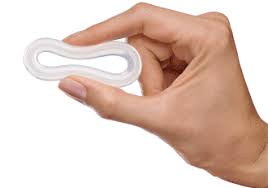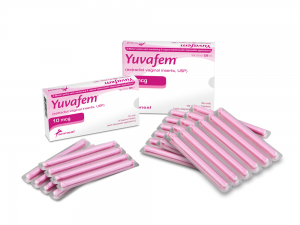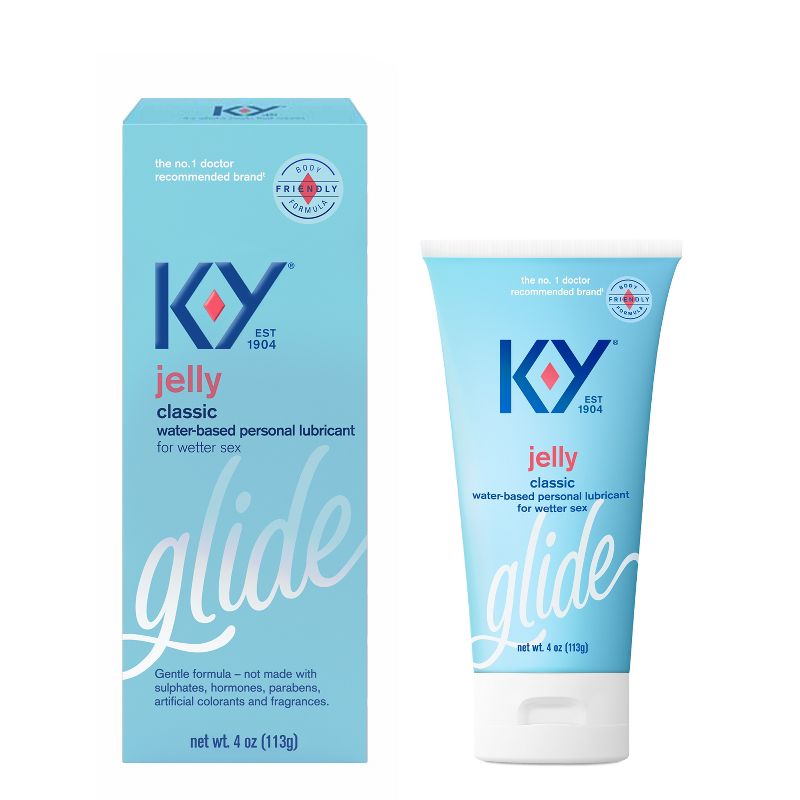This is the average age of menopause in the U.S.
What is 51?
Perimenopause occurs on average at age 47 and typical changes that are seen are longer and shorter cycles, with occasional skipping. There may also be changes seen in the amount of menstrual bleeding.
True or False: older patients with vaginal dryness symptoms do not need a pelvic exam
What is False.
Pelvic exam is needed to confirm the diagnosis. The differential includes:
●Vaginal infections (eg, candidiasis, bacterial vaginosis, trichomoniasis)
●Vulvar dermatitis (reaction to deodorants, soaps, panty liners, spermicides, lubricants, or tight fitting/synthetic clothing)
●Lichen planus- rare inflammatory derm condition p/w pain, burning, itching, soreness, or dyspareunia

●Lichen sclerosus- benign inflammatory derm condition p/w pruritis, dyspareunia, or dysuria

●Genital tract ulcers or fissures
These are two contraindications to oral estrogen therapy
What is a history of breast/uterine cancer or thromboembolic disease?
Also CI with active liver disease, unexplained vaginal bleeding, CHD, or TIA
This is an example of a behavioral change taken to help with vasomotor symptoms
What is avoiding hot flash triggers (eg, caffeine, alcohol, spicy food) or dressing in layers?
While obesity is a risk factor for hot flashes, the evidence is inconclusive for losing weight to reduce hot flash symptoms.
We have lots of data that shows that exercise does not help hot flashes. Given the raise in core body temperature while exercising, this is sadly not really surprising.
This is the most common cause of PMB
What is atrophy of the vaginal mucosa or endometrium?
In the early postmenopausal years, also consider endometrial hyperplasia, polyps, and submucosal fibroids.
While endometrial cancer only occurs in 10% of PMB cases, it is the only lethal cause, and the prevalence is higher in those with RFs.
Definition of menopause and the role of FSH in diagnosis
What is determined retrospectively after a woman has experienced 12 months of amenorrhea without other pathologic or physiologic cause?
FSH is not necessary to make the diagnosis of menopause in a woman >45 with typical symptoms.
Serum FSH concentrations can vary widely during the transition.
For women 40-45, other causes of amenorrhea must be ruled out (thyroid DO, pregnancy, hyperprolactinemia)
These are 2 of the 4 ways declines in serum estrogen levels leads to urogenital atrophy
-Loss of collagen content of epithelium, affecting thickness and elasticity
-Falling levels of muchopolysaccharides and hyaluronic acid, which keep epithelial surfaces moist
-Less blood flow to the genital region
-Change in the normal vaginal flora due to loss of lactobacilli (and therefore loss of the normal acidic environment)
This is why uterine status matters in selection of HRT agent.
What is unopposed estrogen therapy?
Unopposed estrogen therapy can cause endometrial hyperplasia.
Women with a uterus should get combined estrogen-progesterone therapy
This is the efficacy of herbal remedies for vasomotor symptoms
What is none?
There is inconsistent evidence on soy/phytoestrogens and black cohosh.
Acupuncture, evening primrose oil, and flaxseed have been shown to be ineffective.
There is some supportive evidence for CBT and hypnosis, more study is needed.
Commonly seen in the U.S., this is the biggest modifiable risk factor for Endometrial Cancer
What is obesity?
OR 1.5 for overweight (BMI 25.0 to <30 kg/m2)
2.5 for class 1 obesity (30.0 to <35 kg/m2)
4.5 for class 2 obesity (35.0 to 39.9 kg/m2)
7.1 for class 3 obesity (≥40.0 kg/m2)
This is the hallmark symptom of menopause
What are hot flashes? Hot flashes occur in up to 80% of women and start in the perimenopausal period. They can last for as long as 20 years in some women.
When they occur at night, they are referred to as night sweats and can lead to poor sleep, with resulting impact on daytime function.
Do not use vaginal estrogen therapy in women with this type of cancer, instead use this
What is breast cancer, and instead use vaginal moisturizers and/or lubricants?
- Lubricants are designed to be applied just prior to sexual activity
-Moisturizers are applied every few days as needed for the patient's comfort. Here are some examples!
Available through the Grady pharmacy
-It is reasonable to use vaginal estrogen therapy in women who have completed treatment for endometrial or ovarian cancers.
True or False: HRT may prevent dementia in post-menopausal women
What is False
The Women's Health Initiative study showed that both unopposed estrogen and combined estrogen-progestin therapy had no global cognitive benefits in older, non-demented postmenopausal women
The general name for treatments that claim to mimic "natural" hormone balance, and often include compounded and non-FDA-approved formulations?
What is bioidentical hormone therapy?
Despite the hype, these treatments have no evidence supporting their efficacy. Additionally, use of compounding pharmacies can confer additional risk.
Steps for evaluation of post-menopausal bleeding after taking a history (name 3 out of 4)
What is pelvic exam, cervical cytology, pelvic ultrasound, and endometrial biopsy?
Primary ovarian insufficiency (POI) can be diagnosed if these criteria are met.
-Age under 40 with vasomotor symptoms of menopause and menstrual irregularities
-Amenorrhea is not required and some women may have oligomenorrhea along with vasomotor symptoms
-Negative hCG, normal TSH, PRL and high FSH, low/normal estrogen

True or False: Vaginal atrophy increases the risk for contracting an STIs, vaginal infections, or UTIs
What is True?
-Changes in the vaginal pH increases the risk for BV
-This also increases the risk of trichomonas infection
-Urinary tract structures have estrogen receptors, with resulting atrophy during menopause, increasing the frequency of UTIs as well as urinary incontinence
-Remember to screen post-menopausal women for STIs as they may not be as vigilant about prevention
-Vaginal estrogen can improve continence and decrease recurrent UTIs
This is a current indication for hormone replacement therapy (1+)
What is
• Treatment of moderate-severe vasomotor symptoms within 10y of menopause or <60 without contraindications
• Treatment of moderate-severe vaginal atrophy (but consider topical instead)?
These are non-hormonal prescription therapies for vasomotor symptoms (name 3 classes)
What are
-SSRIs: paroxetine (10 and 20mg/d), citalopram (20mg/d), escitalopram (10-20mg/d)
-SNRIs: venlafaxine (37.5-75mg/d) and desvenlafaxine (50-100mg/d)
-Anticonvulsants: gabapentin (300mg/d-2.4g/d in divided doses), pregabalin (50mg/d-150mg BID)
All of the above are off-label uses except for paroxetine which is FDA approved for vasomotor symptoms.
True or False: A normal pelvic ultrasound with endometrial stripe <5mm excludes the diagnosis of endometrial cancer
FALSE. A woman with isolated bleeding and a normal endometrial stripe (no heterogeneity, no thickening) can be monitored, but persistent bleeding should still prompt referral for a biopsy!
FSH measurement is helpful in diagnosing the menopausal transition in these 4 subgroups of women. (Name 2 of 4)
Who are patients with PCOS, prior hysterectomy, LNG-IUS or progesterone implants, and taking COCs?
If on COCs, stop it at age 51 and measure FSH 2-4 weeks later. A level ≥25 IU/L indicates that the patient has likely entered menopause.
These are 3 of the 5 brand-name preparations of topical estrogen therapy
What is Estring (vaginal ring) - leave in for 3 months

Imvexxy (4mcg) or Vagifem/Yuvafem (10mcg) - use daily for 2 weeks then twice a week. Start low, increase to higher dose if needed.



Premarin/Estrace (cream) - use daily for 2 weeks then twice a week.
These are two risks, and one benefit of hormone replacement therapy-- aside from treatment of symptoms of menopause
RISKS: What is thrombosis, stroke/cardiovascular events, and breast cancer?
Absolute risks for HT use in healthy women ages 50-59 are low; HT initiation in older women carries higher risks
BENEFITS: What are decreased fracture risk and decreased colon cancer risk?
This is the most recently FDA approved drug for use in menopausal hot flashes

Fezolinetant 30mg/day or 45mg/day
An Neurokinin 3 receptor (NK3R) antagonists. Estrogen inhibits the NKB thermoregulatory system in the hypothalamus. As estrogen declines in menopause, there is dysregulation of the receptor with higher NKB levels, leading to vasomotor symptoms. This drug helps to decrease NKB signaling.
These are 3 of the risk factors in the development of endometrial cancer
-Increasing Age (1.4% prevalence in ages 50-70)
-Unopposed estrogen (RR=2-10)
-Late Menopause (>55), early menarche, nulliparity
-Diabetes (RR=2)
-PCOS (RR=3)
-Family history or genetic tumor syndrome (Lynch Syndrome, Cowden syndrome)
